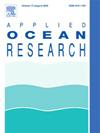Numerical study on propeller flow field in four quadrants
IF 4.4
2区 工程技术
Q1 ENGINEERING, OCEAN
引用次数: 0
Abstract
The propeller hydrodynamic performance under different direction combinations of the uniform inflow and the propeller rate, i.e. four quadrants (Q1–Q4) conditions, is studied with CFD methods, and validated by the experimental data of a model-scale propeller. The numerical strategies including the turbulence model, the grid size, and the time step are discussed. Regarding the relative direction of the inflow and the propeller jet, RANS (Reynolds-Averaged Navier–Stokes) and DDES (Delayed Detached Eddy Simulation) are compared in resolving global and local flow quantities. RANS results show similar near-field flow fields to DDES results in Q1/Q3, while DDES gives more accurate forces and richer flow details such as vortex resolutions for cases with opposite flow directions. Then the propeller is simulated by RANS in Q1/Q3, and by DDES in Q2/Q4. In four quadrants, the propeller thrust and torque, vortex structures, and velocity and pressure distributions are presented for flow mechanism analysis. In Q1/Q3 conditions, the propeller jet evolves in the same direction as the inflow, promising a converged flow field. In Q3, the reverse rotation leads to less significant flow acceleration effects than Q1 under the same inflow velocity, and the non-uniformity of pressure distributions on the blades is strengthened. For Q2/Q4, massive flow separations occur due to the interaction of the propeller jet and counter inflow, and the recirculation zone with reversed axial velocities forms. With increased inflow velocities, the dominant role between the inflow and the propeller jet gradually shifts, and the difference in the propeller jet produced by ahead and astern rotations postpones the shift in Q2 compared with Q4. This study investigates the propeller flow field in four quadrants and can help to quantify rudder inflow variations in hull-propeller-rudder interactions for future research.
螺旋桨四象限流场的数值研究
采用CFD方法研究了四象限(Q1-Q4)条件下均匀入流与螺旋桨速度不同方向组合下螺旋桨的水动力性能,并通过模型螺旋桨的实验数据进行了验证。讨论了湍流模型、网格尺寸和时间步长等数值策略。针对来流与螺旋桨射流的相对方向,比较了reynolds - average Navier-Stokes法和DDES法在求解全局流量和局部流量方面的效果。在第一季度和第三季度,RANS结果显示了与DDES结果相似的近场流场,而DDES给出了更精确的力和更丰富的流动细节,如流动方向相反的涡旋分辨率。然后在Q1/Q3和Q2/Q4分别用RANS和DDES对螺旋桨进行了仿真。在四个象限中,给出了螺旋桨推力和扭矩、涡结构、速度和压力分布,用于流动机理分析。在Q1/Q3工况下,螺旋桨射流的发展方向与流入方向相同,形成了一个收敛的流场。在Q3中,在相同的流入速度下,反向旋转导致的流动加速效应不如Q1显著,叶片压力分布的不均匀性得到加强。对于Q2/Q4,由于螺旋桨射流与反流入的相互作用,出现了大量的流动分离,形成了轴向速度相反的再循环区。随着来流速度的增加,来流与螺旋桨射流之间的主导作用逐渐发生变化,正倒转产生的螺旋桨射流差异使Q2较Q4的变化有所推迟。本研究研究了四个象限的螺旋桨流场,有助于量化船体-螺旋桨-方向舵相互作用中方向舵流入的变化,为未来的研究提供依据。
本文章由计算机程序翻译,如有差异,请以英文原文为准。
求助全文
约1分钟内获得全文
求助全文
来源期刊

Applied Ocean Research
地学-工程:大洋
CiteScore
8.70
自引率
7.00%
发文量
316
审稿时长
59 days
期刊介绍:
The aim of Applied Ocean Research is to encourage the submission of papers that advance the state of knowledge in a range of topics relevant to ocean engineering.
 求助内容:
求助内容: 应助结果提醒方式:
应助结果提醒方式:


